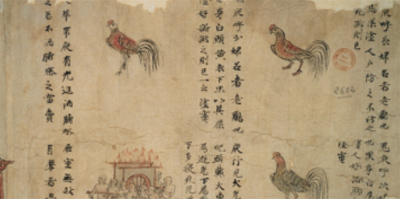|
||
      |
Original Source
Demon diagrams
In medieval China “a knock at the door could be a devil,” says East Asian languages and civilizations professor Donald Harper. To understand the spirit world, the Chinese might consult a manuscript such as “Diagrams of White Marsh” (below) , which teaches, for example, what to do when a female pheasant enters a house or a leather belt glows at night—both demonological occurrences. “White Marsh was a medieval Chinese deity,” Harper explains, “believed to protect people from harm.”

Illustrated with paintings of demon-related events, “Diagrams of White Marsh” is one of more than 50,000 manuscripts found in man-made caves near Dunhuang, China, that served as Buddhist temples between the 4th and 14th centuries. Harper researches manuscripts with illustrated medical guides, sky charts, calendars, and instructions for predicting the future based on numerology, sorting sticks, and hexagrams.
Modern readers might be surprised, Harper says, by the “easy contact between the human and spirit world” in ancient China. Demons were implicated in all sorts of everyday events, he says, such as “when you go outside in the morning and there are crows.” While concerns about demons seem foreign today, these texts also answer age-old anxieties, Harper says—such as, “How do you pick a good day to get married?”
Most Dunhuang manuscripts are at Paris’s French National Library, where “Diagrams of White Marsh” resides, or at London’s British Library. The University of Chicago owns one scroll, bought during the 1960s and held in the Regenstein Library’s East Asian collection. Inscribed on the scroll, says Yuan Zhou, curator of the East Asian collection, are Buddhist sutras, or scriptures, describing the origin of the universe.